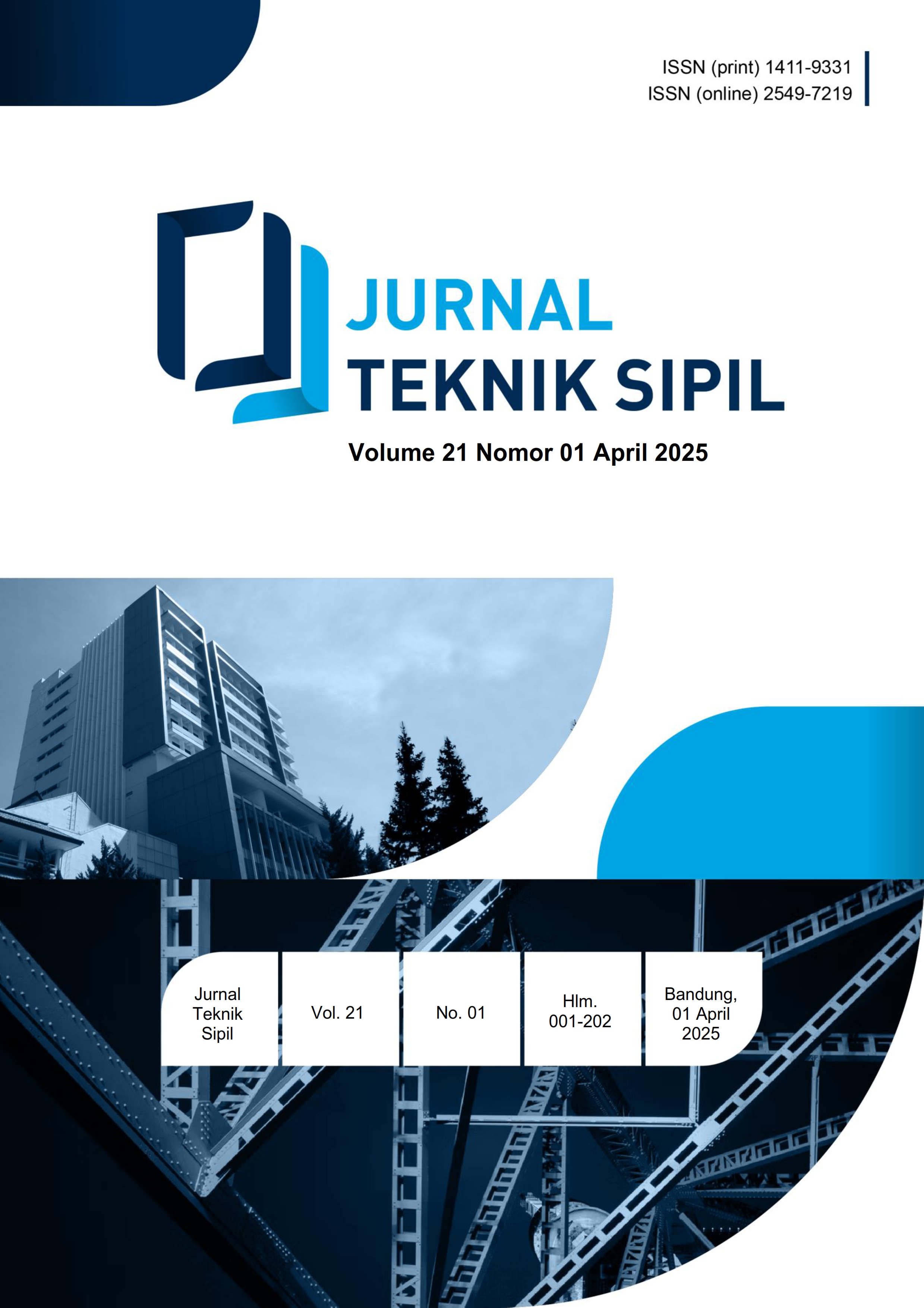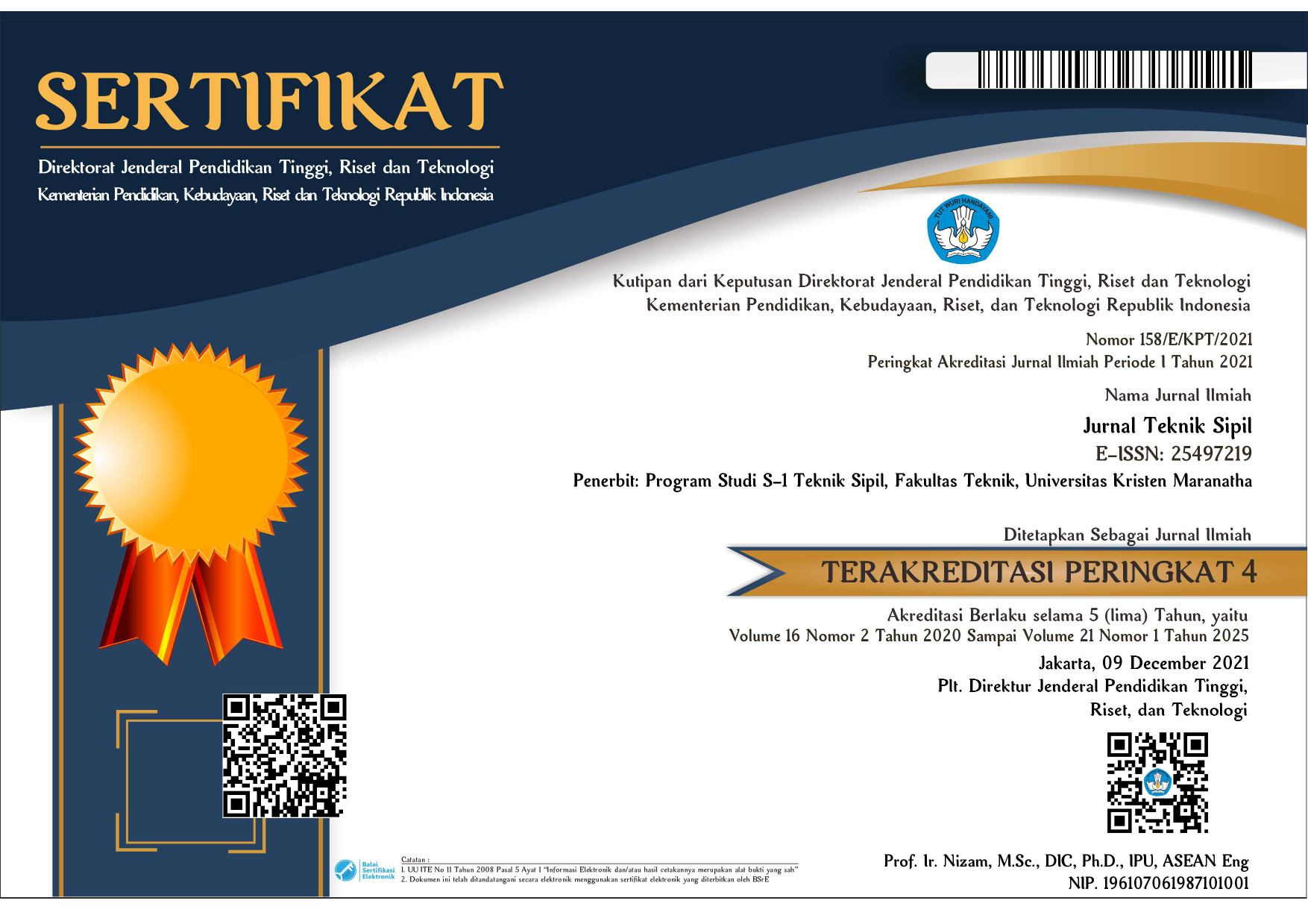Evaluasi Kuat Tekan Beton Terpasang pada Struktur Dermaga Eksisting Berdasarkan Pengujian Destructive dan Non-Destructive
DOI:
https://doi.org/10.28932/jts.v21i1.8698Kata Kunci:
DT, Hammer Test, Korelasi, Kuat Tekan Ekuivalen, NDT, Pengujian Struktur, UPVAbstrak
Dermaga merupakan bagian penting suatu pelabuhan karena berfungsi sebagai sarana tambat dan sandar kapal, karenanya penting untuk dipastikan setiap dermaga memiliki fasilitas yang baik dan layak untuk digunakan, baik dari segi operasional maupun dari kekuatan strukturnya. Salah satu bentuk evaluasi dermaga eksisting adalah dengan melakukan pengujian struktur yang bertujuan untuk mendapatkan parameter material yang akan menjadi input untuk permodelan struktur eksisting. Parameter material yang akan dihasilkan berupa nilai kuat tekan beton ekuivalen yang selanjutnya menjadi acuan dalam permodelan struktur eksisting. Pengujian yang dilakukan berupa pengujian merusak (destructive test, DT) dan pengujian tak merusak (non-destructive, NDT). Untuk mendapatkan hasil pengujian yang merepresentasikan kondisi struktur eksisting secara keseluruhan, setiap pengujian harus dikorelasikan dengan pengujian lainnya. Korelasi pengujian yang dianalisis adalah antara pengujian core drill dengan hammer test dan korelasi antara pengujian core drill dengan ultrasonic pulse velocity (UPV). Hasil korelasi yang dipilih untuk permodelan struktur adalah hasil korelasi pengujian core drill dengan UPV. Besaran kuat tekan ekuivalen berdasarkan analisis adalah 21,41 MPa untuk segmen 1, 24,1 MPa untuk segmen 2, dan 23,18 MPa untuk segmen 3. Hasil analisis yang menunjukkan terdapat perbedaan nilai kuat tekan ekuivalen untuk setiap segmennya. Hal tersebut dimungkinkan terjadi akibat adanya perbedaan tahun pembangunan dermaga untuk setiap segmennya dan sejalan dengan didapatkannya perbedaan nilai kuat tekan beton ekuivalen.Unduhan
Referensi
ACI 214.4R-10.2010. Guide for obtaining cores and interpreting Compressive Strength Results. American Concrete Institute.
ACI 562.2019. Code Requirements for Assessment, Repair, and Rehabilitation of Existing Concrete Structures and Commentary. American Concrete Institute.
Al-Nu’man, B.S., Aziz, B.R., & Khaleel, S.E. (2015). Compressive Strength Formula for concreter using Ultrasonic Pulse Velocity. International Journal of Engineering and Technology (IJETT), Vol.26, No.1.
Arifatunurrillah, A., Saputra, A., Sulistyo., D., (2019). Pengaruh Air Laut Pada Masa Perendaman Terhadap Infiltrasti Ion Klorida Pada Beton dengan Menggunakan Semen Portland Tipe V. Jurnal Riset Rekayasa Sipil Universitas Sebelas Maret, ISSN: 2579-7999.
ASTM C597.2002. Standard Test Method for Pulse Velocity Through Concrete.
ASTM C1604.2005. Standard Test Method for Obtaining and Testing Drilled Cores of Shotcrete.
ASTM C805.2018. Standard Test Method for Rebound Number of Hardened Concrete.
ASTM E178-02.2003. Standard Practice for Dealing with Outlying Observations.
Aydin, F., & Saribiyik, M., (2010). Correlation Schmidt Hammer and compressions testing for concretes in existing buildings. Scientific Research and Essays Vol.5(13), pp.1644-1648.
Chairunnisa, N., & Pratiwi, A., (2023). Pendapingan Teknis Pengujian Non Merusak dengan Ulitrasonic Pulse Velocity dan Hammer Test pada Struktur Beton Bertulang Bangunan Kantor di Banjarbaru. Jurnal pengabdian Ilung, Vol.3, No.1.
Haavisto, J., Husso, A., Laaksonen, A., (2020). Compressive strength of core speciments drilled from concrete test cylinders. Wiley, Structural Concrete. 2021;22(suppl.1): E68.-E695.
Ichsan, M., Tanjung, D., Hasibuan, M., (2021). Analisa Perbandingan Hammer Test dan Compression Testing Machine Terhadap Uji Kuat Tekan Beton. Buletin Utama Teknik Vol.17 No. 1.
Khoeri, H., (2016). Non-Destructive Test Terhadap Semi Destructive Test Pada Shear Wall Beton Bertulang. Jurnal Konstruksia vol.7 no.2.
Komala, A., & Juliafad, E., (2022). Evaluasi Kuat Tekan Beton pada Bangunan Gedung Sekolah Dasar Negeri 09 Pasaman. Applied Science in Civil Engineering, Vol.4, No.2.
Sanchez, K., & Tarranza, N., (2014). Reliability of Rebound Hammer Test in Concrete Compressive Strength Estimation. Int’l journal of Advances in Agricultural & Environmental Engg (IJAAEE) Vol.1 ISSN 2349-1523 EISSN 2349-1531.
Shariati, M., Sulong., N., Arabnejad, M., Shafigh., P., & Sinaei, H., (2010). Assessing the strength of reinforced concrete structures through Ultrasonic Pulse Velocity and Schmidt Rebound Hammer test. Scientific Research and Essays Vol 6(1), pp. 213-220.
##submission.downloads##
Diterbitkan
Cara Mengutip
Terbitan
Bagian
Lisensi
Hak Cipta (c) 2024 Yudi Herdiansah, Widhi Prima Cendana

Artikel ini berlisensi Creative Commons Attribution-NonCommercial 4.0 International License.
























